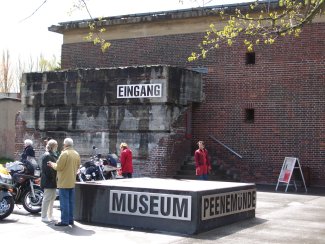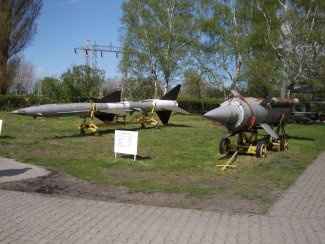Telephone: +49 (0)38371-505-0
Website: http://www.peenemuende.de
Shop: shop present
Restaurant/refreshments: refreshments
Size of the museum/site: large
Year of visit: 2005
Overall rating:

Description: In 1936 the history of Peenemünde changed and Peenemünde in turn changed history. While it was only in 1928 that this rural village in the northern part of the island of Usedom got electricity, it would soon become one of the world's most advanced research centres of its time: the rocket development and testing area Peenemünde that was built in 1936. This area was of great importance to the Nazis in their search for new, powerful weapons that would help them to make Germany a super power and that could be decisive in turning the rigid balance of power in Europe to their side. The Flugbombe Fi 103 and the Rakete A4, generally known as the V1 and V2 ('V' stands for Vergeltungswaffe, which means retaliatory weapon), are the most notorious products that ever came from the Peenemünde 'factory'.
The Peenemünde Museum is only a small part of the entire 'Versuchungsanstalten' (research area) that once was a village on its own. Roughly speaking the museum consists of the former powerhouse and a small control bunker. On these premises you can have a look at a few aeroplanes/jetfighters and helicopters from the GDR era. At the far end of this area (in the harbour) there's a small rocket speedboat which can be boarded. This Tarantula-class boat served in the GDR-navy only from 1986 to 1990. Of course an original V1 and V2 aren't missing from the exhibition. After WW II the powerhouse has still been used to generate electricity for decades. So some of the interior is original, but some has also been renewed.
The exhibition inside the powerhouse is build up in two parts. The first part showing the most of the power house (though not all parts are accessible yet), telling the history of the Peenemünde research area and of the development of the V1 and V2. This is explained with the help of some nice scale models that give the visitor an idea of what the buildings and testing/launching facilities, that stood in Peenemünde more than 60 years ago, looked like. It's worth mentioning that the everyday life of both scientists and (forced) labourers gets a lot of attention in these descriptions. The second part of the exhibition describes the role that the German research and experience in rocket technology played in the years following WWII, for both military (long range missiles) and civil/scientific purposes like travelling to the moon or bringing satellites into orbit.
Experiments with rockets had been carried out before, but the Nazis, with a team of scientists led by Wernher von Braun, were the first to successfully apply rocket-technology in long range weapons. This resulted in the use of the V1 and V2 in bombardments on several cities in northwest Europe, like London and Antwerp. The goal was of course to do as much damage as possible to the cities, but maybe even more important was the effect of frightening the population. The noise was awful, but at the moment the engines stopped people really got scared (because that meant that the rocket would fall down and explode).
All in all it's interesting to get information about the role rockets like the V1 and V2 played in WW II, but the location itself is unique and is the main reason to visit this museum. When you visit the Historisch-Technisches Informationszentrum Peenemünde, you might want to check out the Maritim Museum U461 that lies close by in the harbour of Peenemünde. Another related museum is La Coupole in northern France, a location from which V-weapons were stored and also launched.









